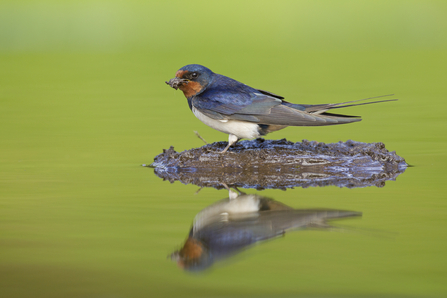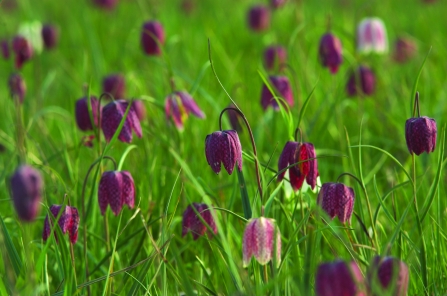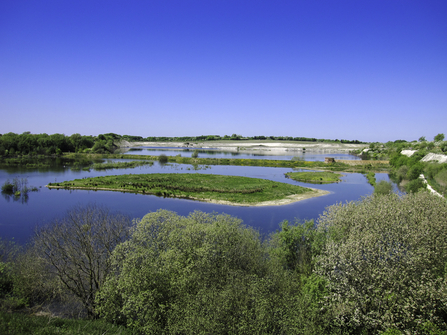
Barn swallow (Hirundo rustica) collecting mud for nest building. Picture by Mark Hamblin/2020VISION

Barn swallow (Hirundo rustica) collecting mud for nest building. Picture by Mark Hamblin/2020VISION
This beautiful lake is surrounded by meadows, ponds and sheltered reedbeds, a great place to watch time go by. Look out for the return of our summer visitors - including house martins, and swallows are early arrivals followed by swifts later in the season. You may even be lucky enough to hear a nightingale singing in the dense scrub.
Access: Mix of grass and surfaced paths, flat around northern part of lake, undulating to south. Narrow bridges. Lakeside paths muddy in winter. Bicycles and horse riding not permitted.
Carpet of bluebells at Moor Copse by Kate Dent
This woodland treasure trove astride the River Pang is a haven of peace and beauty, renowned for its flowers, butterflies and moths.
In spring, woodland flowers and meadow flowers provide a colourful carpet whilst birds sing their hearts out.
Access: Flat, soft ground after rain, can flood in winter; some cross slopes and coarse aggregates on paths, gates.

The sight of thousands of purple and white chequered snake's-head fritillaries at these ancient wet meadows will take your breath away. Each spring, Iffley Meadows plays host to a wonderful wildlife spectacle where you can enjoy Oxfordshire's iconic flower, the snake's-head fritillary, in bloom in its natural surroundings along with other wild flowers.
Before BBOWT took over management of the nature reserve in 1983, a mere 500 of these flowers could be found. As a result of BBOWT's careful management of the site and controlled grazing, numbers of fritillaries have shot up to over 89,000 in a good year - a huge success story. Look out for the results of this year's count later in the spring when we will find out the effect of the wet winter on the numbers.
Access: Flat overall; rough underfoot in places, wet patches all year; kissing gates, gates, 30m 1 in 4 ramp from road to towpath.

©Guy Edwardes/2020VISION
Spring marks the start of these grasslands transforming into wildflower meadows which will be at their peak in early summer. Cowslips start the succession of flowers and the variety grows through the season.
Chimney Meadows is also important as a home for nationally declining wading birds such as curlew, which breed here. Listen out for their distinctive cur-lee calls across the meadow.
There's a new raised observation platform off the Thames Path with views across the National Nature Reserve and over the river to Duxford Old River. Make sure you pay a visit to see what you can spot.
Access: Some paths and the two bird hides are suitable for people with limited mobility. Contact BBOWT for further information on 01367 870904.

Steve Mendham
Spring is in the air and the breeding season is beginning. Look out for our water birds performing their courtship rituals. From lapwings flying acrobatically high overhead to great crested grebes performing their 'weed dance' there is plenty of activity to enjoy at the nature reserve.
During the Easter holidays, there are family trails and fully-supervised day camps for children. Find out more here.
Access: Gentle slopes, 90% surfaced paths, gates, benches. Please note: some of our paths are uneven.
Some wheelchair access, including hides; two mobility Tramper vehicles are avaliable to use - contact us on 01442 826774 or collegelake@bbowt.org.uk to book.

Orange tip on cuckooflower by Ross Hoddinott/2020VISION
This is a wonderful nature reserve to visit from April to early July when the wild flowers are in bloom and butterflies abound. Cowslips and cuckooflower are some of the first flowers to bloom followed by green-winged orchids later in the spring.
Over 100 plant species have been recorded here thanks to BBOWT's careful management, and it is worth just standing quietly for a moment to take in the buzz and hum of the insects and the spectrum of colour.
You can still see the old ridge-and-furrow pattern here from ploughing in days gone by. Some plants like cuckooflower prefer the wetter furrows while others like meadow buttercup prefer the drier ridges, and this give the stripy appearance to the fields.
Access: The ground is flat but can be uneven and soft after rain, and there are some kissing gates.